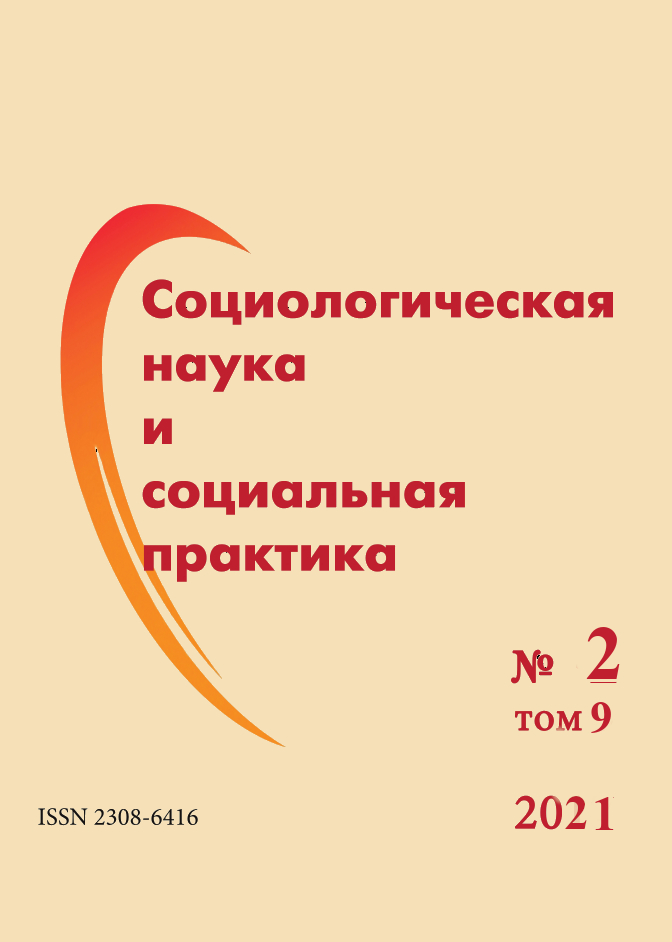Family Values of the Population of Bashkortostan Against the Background of Other Russian Regions: Between Tradition and Modernity
Research Article
Abstract
References
2. Gurko T. A. (20130. O Kontseptsii gosudarstvennoi semeinoi politiki Rossiiskoi Federatsii na period do 2025 goda: ekspertnaya otsenka. [About the Concept of the State family policy of the Russian Federation for the period up to 2025: expert assessment]. Sociologicheskaya nauka i social’naya praktika. № 3(03). P. 33–52. (In Russ.).
3. Gurko T. A. (2020). Teoreticheskie podkhody k izucheniyu transformatsii instituta sem’i. [Theoretical approaches to the study of the transformation of the institute of family]. Sotsiologicheskii zhurnal. T. 26, № 1. P. 31–54. DOI: 10.19181/socjour.2020.26.1.7052. (In Russ.).
4. Gurko T. A., Mamikonyan M. S. (2018). Ustanovki studentov v brachno-semeinoi sfere i otnosheniyakh mezhdu polami. [Attitudes of students in the marriage and family sphere and relations between the sexes]. Vestnik Instituta sotsiologii. № 4 (27). P. 192–226. DOI: 10.19181/vis.2018.27.4.547. (In Russ.).
5. Demograficheskoe samochuvstvie regionov Rossii. Natsional’nyi demograficheskii doklad-2020. (2021). [Demographic well-being of Russian regions. National Demographic Report-2020]. Ed. by T. K. Rostovskaya, A. A. SHabunova; FNISTS RAN. M. : ITD «PERSPEKTIVA» publ. 214 p. (In Russ.).
6. Egorova N. YU. (2017). Transformatsiya supruzhestva v kontekste semeinykh tsennostei. [The transformation of marriage in the context of family values]. Vestnik PNIPU. Sotsial’no-ekonomicheskie nauki. № 2. P. 18–32. DOI: 10.15593/2224-9354/2017.2.2. (In Russ.).
7. Zubok YU. A., CHuprov V. I. (2018). Otnoshenie molodezhi k sem’e v izmenyayuscheisya sotsial’noi real’nosti. [The attitude of young people to the family in the changing social reality]. Sem’ya v sovremennom obschestve. Seriya «Demografiya. Sotsiologiya. Ekonomika». Ed. by S. V. Ryazantsev, T. K. Rostovskaya. T. 4, № 1. M. : Izd-vo «Ekon-inform» publ. P. 103–108. (In Russ.).
8. Makkarti Dzh. R., Edvards R. (2018.) Issledovaniya sem’i. Osnovnye ponyatiya. [Family research. Basic concepts]. Ed. by E. YU. Rozhdestvenskaya. M. : Izd. dom Vysshei shkoly ekonomiki publ. 343 p. DOI: 10.17323/978-5-7598-1315-6. (In Russ.).
9. Nazarova I. B., Zelenskaya M. P. (2019). Brak, sem’ya, obuchenie: ustanovki i predstavleniya studentov. [Marriage, Family, Learning: Student Attitudes and Perceptions]. Sotsiologicheskie issledovaniya. № 7. P. 78–89. DOI: 10.31857/S013216250005795-7. (In Russ.).
10. Naselenie Rossii 2015. Dvadtsat’ tretii ezhegodnyi demograficheskii doklad. (2017). [Population of Russia. Twenty-third annual population report]. Ed. by S. V. Zakharov. M. : Izd. dom VSHE publ. 360 p. Demoskop weekly : [sait]. URL: http://www.demoscope.ru/weekly/knigi/ns_r15/sod_r.html (data obrascheniya: 07.12.2020). (In Russ.).
11. Respublika Bashkortostan. Demograficheskii doklad. Vyp. 1. (2014). [Republic of Bashkortostan. Demographic report. Is. 1]. Ed. by R. M. Valiakhmetov, G. F. KHilazheva. Ufa : Vostochnaya pechat’ publ. 196 p. (In Russ.).
12. Respublika Bashkortostan. Demograficheskii doklad. Vyp. 3. (2018). [Republic of Bashkortostan. Demographic report. Is. 3]. Ed. by G. F. KHilazheva, N. K. SHamsutdinova. Ufa : Bashk. entsikl. Publ. 132 p. (In Russ.).
13. Rostovskaya T. K., Kuchmaeva O. V. (2018). Diskurs o modeli sovremennoi rossiiskoi sem’i i strategiya semeinoi politiki. [Discourse on the model of the modern Russian family and the strategy of family policy]. Sem’ya v sovremennom obschestve. Seriya «Demografiya. Sotsiologiya. Ekonomika». T. 4, № 1. Ed. by S. V. Ryazantsev, T. K. Rostovskaya. M. : Izd-vo «Ekon-inform» publ. P. 33–41. (In Russ.).
14. Rostovskaya T. K., Kuchmaeva O. V. (2020). Transformatsiya obraza zhelaemoi modeli sem’i u raznykh pokolenii: rezul’taty vserossiiskogo sotsiologicheskogo issledovaniya. [Transformation of the image of the desired family model in different generations: the results of the All-Russian sociological study]. Vestnik RUDN. Seriya: Sotsiologiya. T. 20, №3. P.527–545. DOI: 10.22363/23132272-2020-20-3-527-545. (In Russ.).
15. Sotsiologicheskii otvet na «natsional’nyi vopros»: primer Respubliki Bashkortostan. (2012). [Sociological answer to the “national question”: the example of the Republic of Bashkortostan]. INAB-5. M. : Institut sotsiologii RAN publ. 124 p. URL: http://www.isras.ru/ inab_2012_05.html (data obrascheniya: 08.12.2020). (In Russ.).
16. Trotsuk I. V., Paramonova A. D. (2016). «Status» instituta sem’i v sovremennom obschestve i semeino-brachnye tsennosti molodezhi. [“Status” of the family institution in modern society and family and marriage values of young people]. Vestnik RUDN. Seriya: Sotsiologiya. T. 16, № 3. P. 552–558. (In Russ.).
Received: 20.12.2020
Accepted: 30.06.2021








 Publisher: Federal Center of Theoretical and Applied Sociology of the Russian Academy of Sciences (FCTAS RAS)
Publisher: Federal Center of Theoretical and Applied Sociology of the Russian Academy of Sciences (FCTAS RAS)